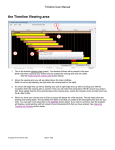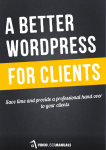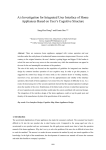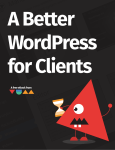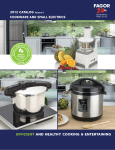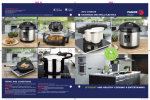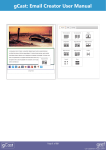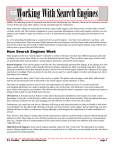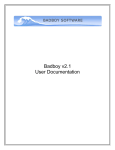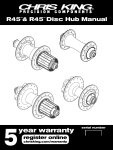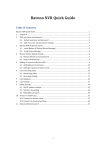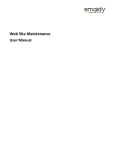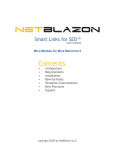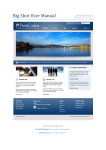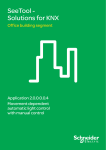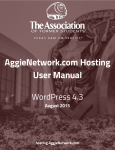Download Pages - Better WordPress For Clients
Transcript
Overview...........................................................................................2 Setting Up Your Clients Dashboard................................................3 Custom Logos......................................................................................................4 Give Clients Editors Access Only ........................................................................5 Removing All Panels From The Dashboard .........................................................5 Remove Unnecessary Menus ..............................................................................7 Allow Client To Easily Edit Their Homepage ........................................................7 Use The New Menus Option In WordPress 3 ......................................................9 Group All Main Menu Sections Below The Dashboard ........................................9 Moving WordPress Menu Positions .............................................12 Reasons For Grouping Important Menu Items...................................................12 Issues You Should Be Aware Of ........................................................................12 How We Handle These Issues ...........................................................................12 OK, How Can I Make The Change Myself? .......................................................13 The Importance Of A Manual For Clients ....................................14 An Example Of How You Can Use The WordPress Manual Plugin....................15 Advantages Of Using The WordPress Manual Plugin........................................16 WordPress Core Plugins...............................................................17 WordPress CMS Setup Checklist .................................................18 WordPress SEO Basics.................................................................19 Permalink Structure ...........................................................................................19 Install The All In One SEO Plugin ......................................................................19 Install the Robots Meta Plugin To Handle Redirects ..........................................20 Use H1 Tags Only For Your Page Titles .............................................................21 Don’t Be Lazy With Your ALT Texts ....................................................................22 Install The Google XML Sitemap Plugin ............................................................22 Add To The Update Services .............................................................................22 Digg....................................................................................................................23 Putting It All Together .........................................................................................23 How To Get The Most Out Of The WordPress Manual Plugin.....27 Customisation Using The Config.php.................................................................27 Disclaimer ......................................................................................29 Rights Notice......................................................................................................30 2 Overview Overview Throughout this report we offer you our tips on how to improve your processes and advice based on our experience. Nothing is set in stone, and we are constantly evolving our own processes, but contained within this report is nearly 6 years of experience of using WordPress as a CMS for clients. The purpose of this report is: • To help you provide a better WordPress CMS for your clients. • To help you improve you processes in setting up WordPress. • To help you provide a more secure WordPress for your clients. • To help you manage your clients questions more efficiently. • To learn more about the WordPress menu system. • To incorporate basic search engine optimisation strategies into you development process. • How to use the WordPress Manual Plugin more efficiently. If you implement just a few of our recommendations, we are sure you will provide a more professional CMS for your clients and will save your company time and money in the future by developing more efficient processes. We would love to hear your feedback on this report, and your methods and processes about how you set up WordPress for your clients. Share your feedback on this report on this page. Please submit any ideas on improvements to the WordPress Manual Plugin here. Copyright 2010 – All rights reserved 3 Setting Up Your Clients Dashboard Setting Up Your Clients Dashboard Our main aim initially was to provide WordPress instructions for clients by providing a great experience for our clients using their WordPress CMS. We realised that first impressions really count. So this is why our current site deployments have a heavily customised dashboard that looks like: We hope you have noticed the following things about this dashboard: • We customise the header and footer logo • We remove all the panels from the dashboard and add in our own welcome panel which is personalised for the client • The welcome panel contains links to the important areas in the CMS • We have removed all the menus that are not relevant to our clients needs. (no more explaining what the links menu means!) • We have a complete video tutorial suite accessible where the client needs it most (in the actual CMS) • We give our clients Editor only access Copyright 2010 – All rights reserved 4 Setting Up Your Clients Dashboard As a small business owner you should be looking to develop processes that are easy to replicate and will save you time and money. This dashboard has evolved because we were constantly looking to improve on our process and provide a better user experience. This is how and why we do it: Custom Logos Which feels more personalised? Now there are lots of plugins out there that will allow you to add your own logos to WordPress, but we were looking for something that was very simple. Every plugin we investigated gave us more functionality than we actually needed. We did not need to waste time Always place your logos in the image folder when you first start to develop the theme. Then install the White Label CMS plugin. changing anchor colours, or background colours, the current WordPress colour scheme is excellent. So we built our own plugin (the White Label CMS plugin). Copyright 2010 – All rights reserved 5 Setting Up Your Clients Dashboard We always modify the login and header logo to be the client’s logo. We also felt it was necessary from our own branding point of view to place our logo in the footer of the CMS, and also provide a link to our website, just as way of making sure the client would not forget us for any future projects they might have! We wanted to make sure that during the design process, we could create a logo for the login and a logo for the header, place them into the images directory of the active theme, so when we activated the plugin, everything would work straight away. Give Clients Editors Access Only The vast majority of our clients are not specialists in IT, and are really only interested in having a website that looks great, and so presents a good image of the company. They don’t care if their plugins are up to date, or the fact they can have links in their blog roll. The less unnecessary options available to the client, the less opportunities for confusion. This is why we usually give our clients just the Editors login, not the Admin login. Removing All Panels From The Dashboard The lack of documentation and the cluttered dashboard was always the achilles heel of WordPress as a CMS. It felt wrong to keep telling clients to ignore the dashboard. A partial solution is provided by WordPress itself. You can simply remove the panels from the dashboard using the Screen Options Remove all panels from the dashboard and add your own welcome panel. tab: Copyright 2010 – All rights reserved 6 Setting Up Your Clients Dashboard However removing all the panels was only marginally better than having all of them there. What we needed was our own custom panel on the dashboard to personally welcome the clients to their CMS. Again, we looked around for a plugin to do this, but in the end decided to incorporate it into our White Label CMS plugin. Most of our builds are actually websites rather than blogs, so we prefer to remove all dashboard panels. However if your client does have a blog attached to their site, then you may consider it necessary to leave some panels on. We have found from our own experience that the clients are really only interested in any comments left on their blog posts, and that is clearly visible on left navigation. Write a generic introduction which you can reuse in the future with a simple copy and paste. The welcome panel we use also has a link to the clients Google analytics account, giving them a better experience by having everything in the one place. Copyright 2010 – All rights reserved 7 Setting Up Your Clients Dashboard Remove Unnecessary Menus One of the biggest problems we have with WordPress is that when you hand the site over to the client, there are a lot of menu items, even when they logged in as the Editor, which are usually not relevant to the clients needs. Clutter creates confusion. In the White Label CMS, we provide a solution for this. With one click you can choose a CMS profile which best fits your clients needs and the unnecessary menus will be removed, from the Editors user role. If you were to choose the Website profile, the navigation would look like this: This is far better for you client, because there is less opportunity for confusion. However, you can make it an even better experience for you clients. Allow Client To Easily Edit Their Homepage We have developed this solution over a long period of time and we are sure it will continue to evolve. Most homepage editing solutions out there are based on having excerpts from existing posts or pages inserted into the homepage, however in a lot of cases, there are extra pieces of information you want to add which are specific to the homepage which don’t fit with in a post or page. If the client wanted to update their homepage it meant doing it in different places, confusion usually reigned. Copyright 2010 – All rights reserved 8 Setting Up Your Clients Dashboard Our solution was to develop an admin page that handles all elements of the homepage. If you want to do this yourself, there is a brilliant article here that explains how to set up an options page in WordPress. We just adapted it to fit our needs. We feel that the most important thing about this page that it is easily customisable. Each website requires something slightly different, but we can simply add a couple more lines to the setup array, and it will appear in the homepage options menu. So adapting this for each client takes seconds rather than hours like it used to. By providing an options page you give the client the ability to change the homepage, but at the same time you restrict what they can actually change as well. Create your own flexible solution for the homepage that can be easily extended for future projects. We have used drag and drop solutions in the past for all clients to modify the homepage, but 90% of them never used Copyright 2010 – All rights reserved 9 Setting Up Your Clients Dashboard them, and the 10% that did, usually ended up calling us because it did not behave the way they expected. Advice: Don!t be afraid to say no to clients when they ask for extra functionality. Sometime it is better (cheaper) for everyone if the developer comes in and makes the requested change, rather than building in the functionality to make it possible … if it is ever requested. Use The New Menus Option In WordPress 3 With the coming of WordPress 3, developers now have a built in solution for managing pages (finally!). However the Menus option is under the appearance section which contradicts what we said about giving clients editor only access. As a web development company we much prefer using the official solution for the menu system, as we know this will be supported in future release, but we did not want to give our clients admin access. The solution we came up with was modifying the White Label CMS plugin to give Editors access to the menus, and widgets page, without letting them change the theme. Group All Main Menu Sections Below The Dashboard When we first started to develop our own plugins, they would all sit at the bottom of the menu system. Telling the client to always use the links at the bottom of the menu felt counter intuitive. Normally the most important links are at the top! Copyright 2010 – All rights reserved 10 Setting Up Your Clients Dashboard For each website we setup we include these extra links underneath the dashboard: • Editing the homepage • Viewing the video tutorials The client can usually run their CMS through those 2 links. It makes sense for us to group them together at the top, and we have had nothing but positive feedback from our clients ever since. In the past we used to include a page navigation plugin similar to PageMash, which we used to control how to the pages appear. However we prefer to use the WordPress Menus now Find your own way of standardizing your installations. Choose your core plugins and stick with them. available in WordPress 3. As explained above, we modified our White Label CMS plugin to allow us to make Appearance -> Menus appear in the menu system, without letting the Editors change the theme. Copyright 2010 – All rights reserved 11 Setting Up Your Clients Dashboard We explain how to position the menus in the next section of this report. There are some technical reasons why you should not do this, the main one being that if WordPress updates, you may overwrite one of the existing sections. However we are comfortable doing this, and we think it provides our clients the best experience. Copyright 2010 – All rights reserved 12 Moving WordPress Menu Positions Moving WordPress Menu Positions It is not very well documented, but it is possible to control the menu positions in WordPress. We do this on our deployments for clients so the important elements of the CMS appear as close to the top as possible. Reasons For Grouping Important Menu Items • If you don’t do this then what usually happens is that your custom plugins usually appear at the bottom of the menu. Intuitively this feels wrong to be constantly directing your clients to use elements at the bottom of the menu system. • Grouping them together makes them easier to explain to your clients. • Taking control of where elements go in the menu system allows you to make sure that the important menu items are available to clients who have the roll of editors (editors can not view the setting panel). Issues You Should Be Aware Of • If you do not have any custom plugins, and rely on using WordPress plugins from other developers, then if you update the plugin you will lose the change you made to the menu system. • You cannot guarantee in future versions of WordPress where the built in menus will appear, so you could potentially overwrite menus accidentally. This is what happened when WordPress 3 was introduced, because the dashboard menu changed item number. How We Handle These Issues The plugins we use are either written by ourselves, or are adaptations of other plugins. We therefore control the updates of the plugin. Copyright 2010 – All rights reserved 13 Moving WordPress Menu Positions We test the plugins with each new version of WordPress, before updating client’s versions of WordPress. So when WordPress 3 came along, we were aware of the issue and made sure it was fixed before upgrading clients sites. We give our clients Editor access, so only we can update the WordPress version, therefore we know if there is going to be a problem. OK, How Can I Make The Change Myself? In the /includes/plugins.php there is the well known function !""#$%&'#(!)%*+. However in the codex, what is not mentioned is that the last variable is the position of where the menu will appear in the menu order: !""#$%&'#(!)%*+,(!)%#-.-/%0+,$%&'#-.-/%0+,1!(!2./.-30+,$%&'#4/')0+,5'&1-.6&++ 7+80+,.16&#'9/++7+80+,(64.-.6&++7+:;<<+=+ Simply by modifying your plugins add_menu_page(), you can move the position. For example to make our Homepage plugin appear directly below the dashboard, we did this: !""#$%&'#(!)%*>?6$%(!)%@0+>?6$%(!)%@0+A0+>B.-!$.&4%6CD6$%(!)%C!"$.&E(D(@0+ >B4%6D!#!"$.&@0FGH(C16&-%&-G(/').&4GB.-!$.&4%6G/6)6E(&)@0@I@=J The existing WordPress menus are as follows: • WordPress 2.9 - dashboard (0), first seperator (4), Posts (5) • WordPress 3 - dashboard (2), first seperator (4), Posts (5) The solution which works on both version of WordPress is to start at ‘3’ and work upwards using ‘3.1’ or ‘3.2’ etc. Copyright 2010 – All rights reserved 14 The Importance Of A Manual The Importance Of A Manual For Clients Imagine you bought a $4000 Television. The person who sold it to you gives you a 30 minute overview of how it works, and sends you off with no manual, but a phone number that if you were to ring would cost you $99 per hour. How would you feel? Your client is expecting a manual from you for their new website. Why? Well because every other significant investment they make for their business, they expect to have something they can fall back upon if they get into trouble. Do you really think 2 hours quick training over a coffee with the client is enough? What happens if the person you trained leaves the business? Do you really want to have a phone call each time they have forgotten what you told them in training? You could produce your own manual but we are sure you have gone through a similar process of constantly producing custom tutorials for clients and underestimating how long this all takes, only to find that WordPress has updated its UI, and the manual is now out of date. Our WordPress Manual Plugin sits perfectly in the WordPress menu system, exactly where your client needs it. It contains over 30 high quality, professionally voiced videos that allow your clients to easily understand complex functionality of their CMS. It also contains a 100 page online manual for clients who prefer to learn by reading. Copyright 2010 – All rights reserved 15 The Importance Of A Manual Every part of this plugin is customisable, so you can rebrand the plugin to give your company a more professional looking handover. You choose which videos you want to appearing. If you want to show only videos about pages and images, you can! Learn more about out WordPress Manual Plugin here. An Example Of How You Can Use The WordPress Manual Plugin This is an example of how to use our Video User Manuals plugin. Later on in this report we will explain how to get the most out of the WordPress Manual Plugin: There are a couple of important things to note: Copyright 2010 – All rights reserved 16 The Importance Of A Manual • The client has a comprehensive video and written manual accessible from the dashboard. • We have created 2 generic videos that cover how to use the homepage and the sitemap which are specific to the way we build websites. • We have adapted the plugin so it contains these videos in the config file, so no modifications are needed to the plugin, it is just a case of installing it, and everything will appear correctly. This saves valuable time. Advantages Of Using The WordPress Manual Plugin • We update the videos and manuals, each time WordPress is updated (think of the time this will save you) • It is part of your clients website, so is easily accessible. • It is a comprehensive manual which covers every aspect of WordPress for the role of an Editor. • You will provide a professional, smoother handover to your clients • It is rebrandable, so if makes your development company appear more professional. • You can install it on all your clients websites. The WordPress Manual Plugin is a powerful plugin, but at the same time it is possible to customise it easily and through a config file and you can install it on your clients sites within seconds, saving you time. For more information on how to get the most out of the plugin, jump forward to this section. Copyright 2010 – All rights reserved 17 WordPress Core Plugins WordPress Core Plugins The following are all plugins that we use on our standard installations. As you probably know there are nearly always about 6 variations of a plugin to solve one issue, and the ones we list below we think do their jobs particularly well. • Plugin Central - We always install the same plugins, and it is laborious process, of installing each one separately, but with this plugin you can install them at the same time. We have a text file on our intranet which contains a link to all the plugins we use, and with one click, they are installed. Saving us between 10 -15 minutes on each install. • All in One SEO Pack - Perhaps the most famous and widely used plugin for WordPress. We like it because it handles the canonical redirects and the easy ability to take control of your titles. However canonicals are now built into WordPress 3, and it was very interesting to hear Matt Cutts say in a recent episode of the WordPress Community Podcast, that he does not now recommend using the plugin, as WordPress now has most of the features you need baked in. • Robots Meta - handling redirects is vital, particularly if you are preforming and update for a client. Being able to view/edit the robots.txt and .htaccess files from inside WordPress make life a lot easier. • Extended KSES - We are increasingly using Google Forms in order to allow clients to collect data directly into spreadsheets, and this plugin allows you to embed iframes into the editor. • White Label CMS - For all the reasons listed above! • Google XML Sitemap - Now that sitemaps are now used by all search engines, this is vital to ensure you have a better understanding of how your site is getting spidered. This plugin has a multitude of options, the defaults options are normally sufficient. • Video User Manuals - Of course, you need a user manual for your client. • Ultimate Google Analytics - We setup Google Analytics for every client, and we like this plugin because it is very simple to use, and it has the option to stop logging if you are logged in as the admin. Copyright 2010 – All rights reserved 18 WordPress CMS Setup Checklist WordPress CMS Setup Checklist Running a successful business is all about processes and checklists. Becoming efficient at things allows you to save time, which translates into you being able to cut the costs of your overheads. The following is our checklist for the creation of each of our development sites. We do not pretend that there is a one size fits all formula for every web development company, but this works well for us. We use Basecamp to manage all our website projects and inside Basecamp we have a custom template which we use to manage the setup of each development site. The steps we follow are: 1. Create a new subdomain 2. Password protect the subdomain 3. Install WordPress on subdomain 4. Create Editor user account 5. Upload VitaminSEO theme and activate the theme 6. Install plugin central 7. Install all plugins using plugin central. Activate each plugin. 8. Change permalinks to be: /%category%/%postname%/ 9. Go to settings->miscellaneous and uncheck organize uploads by month 10. Change title name in All in One SEO to website name 11. Go to White Label CMS 1. Add custom panel to dashboard with standard text. 2. Set CMS profile to website 3. Enable Menus for editors 12. Go to WordPress File Monitor, enter email address, dashboard alert = no. Copyright 2010 – All rights reserved 19 WordPress SEO Basics WordPress SEO Basics Given the vast number of great plugins out there for WordPress there is really no excuse not to include some basic SEO elements into your clients website. You don’t have to be an SEO expert to understand how it works, in most cases it is just common sense and actually improves the usability of the website. Permalink Structure The following recommendation is based on you setting up your clients CMS so that is uses pages and page parents in order to implement the site structure. Set your permalink structure to /%category%/%postname%/ . This allows you to structure your clients website better which helps with search engine optimisation. This structure also works well if the website has a blog as well. If it does, all you need to do is set up a category called Blog, and the blog ‘homepage’ will be / blog/ . All posts should be tagged with either the category “Blog” or a sub category. Make sure you set the default category to Blog. When you create new pages, try and keep the slug as short as possible and use the keywords you want to target. By default, WordPress will take your whole page title as the slug, which is not always the best option. Install The All In One SEO Plugin Make sure you modify the Home Title, and the Home Description. Google has always claimed that meta keywords are not part of its algorithm, but it is still part of other search engines algorithms, so it does not harm to have them there. Copyright 2010 – All rights reserved 20 WordPress SEO Basics The plugin does a number of things very well and we recommend keeping the default settings for everything. The plugin will create meta descriptions automatically, and meta keywords from the tags. It also gives you the option to change the page titles as well, which we highly recommend you do. Target the SEO page title to the keywords you want to rank for, but use the post title to be more descriptive for your users. This is a common technique used by news organisation. This example is from the BBC website: The headline (title) meant to lure the human reader: “Tulsa star: The life and career of much-loved 1960’s singer.”, but the SEO title is “Obituary: Gene Pitney.”. If you want to read more about this, take a look at this 2006 article in the New York Times. The advice is still relevant today. Install the Robots Meta Plugin To Handle Redirects This plugin is very important if you are working on a redesign of a website. It is a common mistake for inexperienced web developers to just redirect every old page to the new homepage. This is not good SEO practice. If possible each page should be redirected to the corresponding new page. Copyright 2010 – All rights reserved 21 WordPress SEO Basics The correct syntax for a redirect is as follows: ,%"-,%./01230456"404&%74 There are lots of articles explaining this is more detail, but the main thing is to redirect to the corresponding page, and to use a 301 permanent redirect, and not a 302 temporary redirect. Use H1 Tags Only For Your Page Titles It very common that themes are set up with the name of the website (usually the logo) being used as an H1 tag. This is not optional from a search engine point of view, because they look at H tags as though they were chapters of a book, which break down what the page is really about. For example, this page is about Basic SEO for WordPress. Not Video User Manuals. If there is a H1 tag in your header remove it and replace it with a div. It is also common for themes to use H2 tags for the page titles. Change the H2 tag to being a H1 tag. Copyright 2010 – All rights reserved 22 WordPress SEO Basics Don’t Be Lazy With Your ALT Texts In WordPress it is very easy just leave the default values in the image editor. Take the extra 10 seconds to think about the keyword the page is trying to target and choose an appropriate description for the image. Do not leave alt text like the one below: Install The Google XML Sitemap Plugin Install the plugin for the client, and it will automatically update when each new page is created. We always set up Google Webmaster Tools for our clients, and make sure the sitemap is verified in the webmaster tools. This only takes a few minutes to do. Add To The Update Services This is not a very well known feature in WordPress, but there is a feature that pings aggregation sites, every time you create a new page. Unfortunately, by default it only includes http://rpc.pingomatic.com/. However, we recommend you simply copy and paste this list of sites into Update Services box. Copyright 2010 – All rights reserved 23 WordPress SEO Basics Click here for a complete list of update services. Digg If you are launching a website for a client, then the fasted way to get it indexed is by Digging it. Google seems to love Digg, and we have always been successful in getting sites indexed within hours rather than days. Putting It All Together We recently identified that the keyword ‘WordPress instructions for clients’ was a keyword we wanted out website to rank for. So we used the above strategy to great effect. We did the following: • Rewrote the article to include the keywords we wanted to target. • Optimised the IMG ALT tags. • Made sure we linked to the post from the homepage. • Used the All In One SEO plugin to write a special optimised title and meta description. • Published the article, so the all the update services were notified. Copyright 2010 – All rights reserved 24 WordPress SEO Basics • We then tweeted the article. • Then we Dugg the article. • We submitted a video to youtube, with optimised titles and keywords. These were the results within 7 hours: Copyright 2010 – All rights reserved 25 WordPress SEO Basics Copyright 2010 – All rights reserved 26 WordPress SEO Basics Results within 48 hours: Copyright 2010 – All rights reserved 27 WordPress Manual Plugin How To Get The Most Out Of The WordPress Manual Plugin This article is meant for power users of the WordPress Manual Plugin. You do not have to modify the config.php file, as there is an options page that is built into the manual and all changes can be made there. However, for companies who do lots of deployments of websites for clients, this process will save you even more time. There is a video that runs through this whole process that can be found here. Customisation Using The Config.php It was only due to popular demand (and the ability to easily update the plugin) that we actually added an options page to the plugin. We don’t actually use it ourselves, because we really value our own time. We have one master copy of the plugin that sits on our intranet. We have already made the following changes in the config.php file. • Our serial code • Show Blogging Videos is set to false – We do not always give our clients blogging functionality • Our custom logo URL – which appears above the videos • Our logo in the custom plugin heading logo – We point it to the themes/ images directory and use the same image as the custom footer logo from our White Label CMS plugin • Our own image for the Custom Ebook Image – We point this to our main server. Copyright 2010 – All rights reserved 28 WordPress Manual Plugin We also modify the Custom Videos in the config.php to include 2 videos. The first video is about how to edit the homepage, the second about how to use our page plugin. We host these videos and thumbnails on our Amazon S3 account. We use the photoshop thumbnail file we provided to make the thumbnails so our videos look consistent with the other videos. The only other piece of customisation we do on the plugin that is not included in the document, is make the plugin appear below the dashboard in the menu system. We have explained above how to recreate this. We highly recommend you watch this 2 minute video which shows you exactly how to do this. Think of the time/money you will save! Copyright 2010 – All rights reserved 29 Disclaimer Disclaimer The information contained in this report contains the opinions of the author as of the date of this publication. Because the Internet moves at warp-speed, the author reserves the right to alter/update his opinion in the future. This report has been provided for informational purposes only. While every attempt has been made to ensure it’s accuracy, neither the author nor his affiliates/partners assume any responsibility for errors, inaccuracies or omissions. After all, they’re only human! The author isn’t a legal professional nor does he claim to be. If you need any legal, business or accounting advice, you should seek the guidance of a professional in your area. While the information contained in this report has been proven to work for the author, he makes no specific guarantees in regards to the outcome you’ll experience. Why, you ask? Well, solid information is great and all, but it doesn’t do any good if it just stays stuck in your head. In order for this information to work, you must take action! Your level of success will largely depend on the time you devote to the information presented, and the amount of action you take. Since these factors will vary from individual to individual, we cannot guarantee your success, nor are we responsible for any of your actions. Any pricing mentioned in this book was determined to be accurate at the time of release. However, we have no control over the third-party websites we may have mentioned, so be sure to review their offerings if you decide to do business with them. WordPress ® and its related trademarks are registered trademarks of Automattic, Inc. Copyright 2010 – All rights reserved 30 Disclaimer This report is not affiliated with or sponsored by Automattic, Inc. or the WordPress ® Open Source project. Rights Notice This report was created for owners of the “WordPress Manual Plugin”. Owners of the plugin are hereby given the right to use this content to their own benefit or to give away the report to their customers, subscriber list or anyone they think might benefit from it. You do not, however, have the right to sell this report or make changes to it. Copyright 2010 – All rights reserved
































